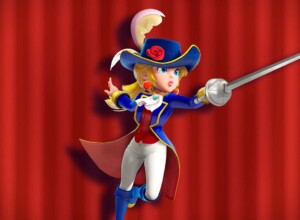Paper Mario: The Thousand-Year Door returns to the Nintendo Switch, bringing a classic RPG back into the limelight.
Conventional wisdom has it that the Paper Mario series is a shadow of its former self. Despite objections from fans, the series has furrowed a path of creativity and experimentation instead of rigidly adhering to the traditional role-playing template.
Whether it’s the use of adhesive power-ups in Paper Mario: Sticker Star, the action-oriented gameplay of Super Paper Mario, the card-based combat system of Paper Mario: Color Splash, or the open-world exploration in Paper Mario: The Origami King, the series’ defining trait is its willingness to explore new concepts rather than sticking to the systems refined in the first three Mario RPGs.
Paper Mario: The Thousand-Year Door, the game many fans consider to be the standard for how it should be done, has now received a glorious HD refresh on Nintendo Switch. In addition to being a feast for the senses, the new release is also an opportunity to reconsider its place in the canon.

The reasons that Paper Mario: The Thousand-Year Door resonates so much with players are clear from the start. The game’s theatrical framing is immediately appealing, from the proscenium setting used during battles – complete with a curtain that rises and falls with each encounter – to the jostling audience that reacts to every move. Mario and his eclectic party of companions feel like players in an elaborate stage production, their actions and dialogue meticulously delivered to entertain and amuse. Indeed, one party member is a self-proclaimed stage diva worthy of a Broadway smash.
As you journey through the eight chapters and 30-hour runtime of Paper Mario: The Thousand-Year Door, it becomes clear that the game is not just a homage to the theatre but a masterclass from Nintendo in how to weave storytelling and gameplay into a cohesive and consistently comic experience. The humor in The Thousand-Year Door is witty and often self-referential. Characters frequently speak with a level of self-awareness and engage in rat-a-tat banter that still hits the mark after two decades.
There’s a verve to the repartee, staging, and scene transitions that also echoes the heyday of live studio sitcoms, a genre rooted in comedy theatre. As supporting characters enter the frame, you can almost hear the audience erupt in Kramer-esque appreciation. And with Luigi’s occasional cameos, the game boasts one of Nintendo’s all-time best gags. (Oh, for a game that tells his story.)

Unfortunately…
the dialogue is…
frustratingly…
slow…
to…
appear…
on…
screen…
…but, thankfully, almost every line is one to savour.
I say almost, as it should be noted that Princess Peach gets a particularly rough ride in moments. Her objectification feels markedly out of place in 2024, and is especially disappointing considering that Vivian’s identity as a transgender woman has finally been respected.

The turn-based battle system of The Thousand-Year Door also aligns perfectly with the game’s embrace of stagecraft. Mario’s party and their opponents take turns in the spotlight, performing their moves to cheers or boos. Falling props and missiles from the audience can impact the outcome of each encounter, adding a layer of strategy and comedic effect. And each battle strikes a delicate balance between accessibility and challenge that accommodates newcomers – and younger players – while still offering enough depth and nuance to satisfy RPG veterans. Whether it lives up to its glowing reputation is questionable, but there’s no denying that the slapstick skirmishes fit the theatrical theme like a glove.
This marriage of presentation and gameplay is so immaculate that Nintendo’s decision to experiment with subsequent titles is understandable. The Thousand-Year Door elevates its predecessors’ achievements – offering more complexity than the Square-developed Super Mario RPG and more eccentricity than Paper Mario’s Nintendo 64 debut – and polishes the role-playing elements to a shine. Its success prompts the question of what’s next. If later instalments don’t reach the same heights, the experimentation itself is valuable. A flawed Paper Mario game is surely preferable to a stack of carbon copies.
One area in which this entry really is a cut above, however, is its eccentric extended cast. Characters like Vivian, Koops, and Punio are truly memorable creations, and it’s a shame that the series is now content to mostly focus on the ‘canon’ inhabitants of the Mushroom Kingdom.

Paper Mario: The Thousand-Year Door is not without some other limitations, especially when compared to the franchise’s most recent entry, Paper Mario: The Origami King. The newer game boasts more expansive environments that create a grander sense of adventure. In contrast, this game’s smaller scale and relatively simple environmental design betray its vintage, despite the beautiful makeover.
Paper Mario: The Thousand-Year Door compensates for the more limited scope with a carefree attitude and tight, cohesive design. The game’s charm lies in its ability to turn these smaller settings into vibrant stages filled with personality and humour, and its engaging approach to storytelling ensures that it’s a classic worth revisiting.

Game: Paper Mario: The Thousand-Year Door
Platform: Nintendo Switch
Developer: Intelligent Systems, Nintendo
Publisher: Nintendo
Release Date: May 23, 2024






